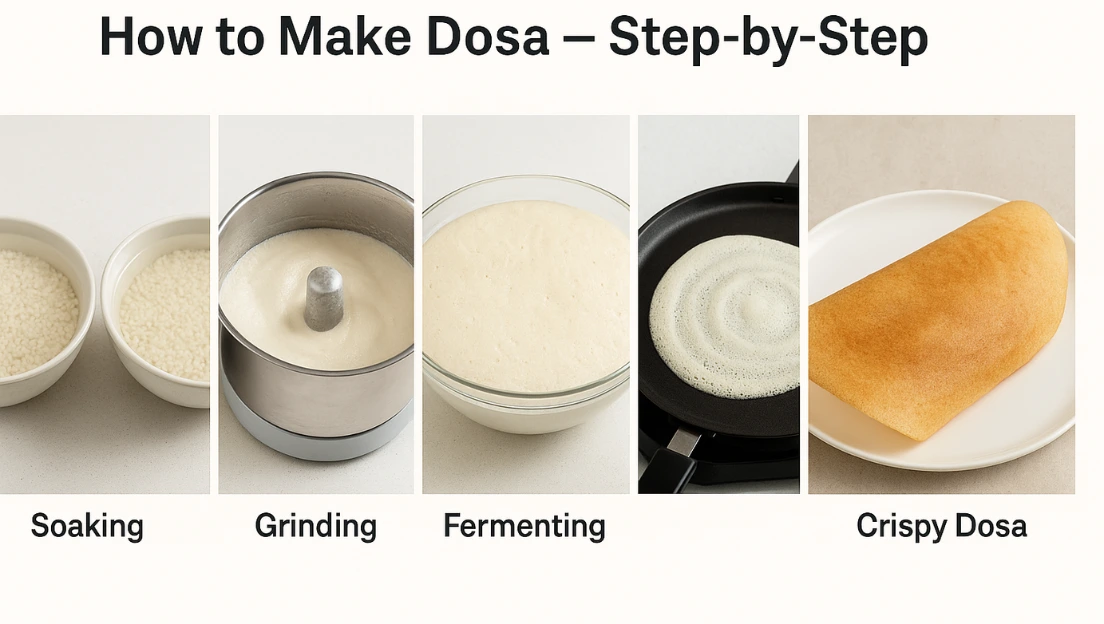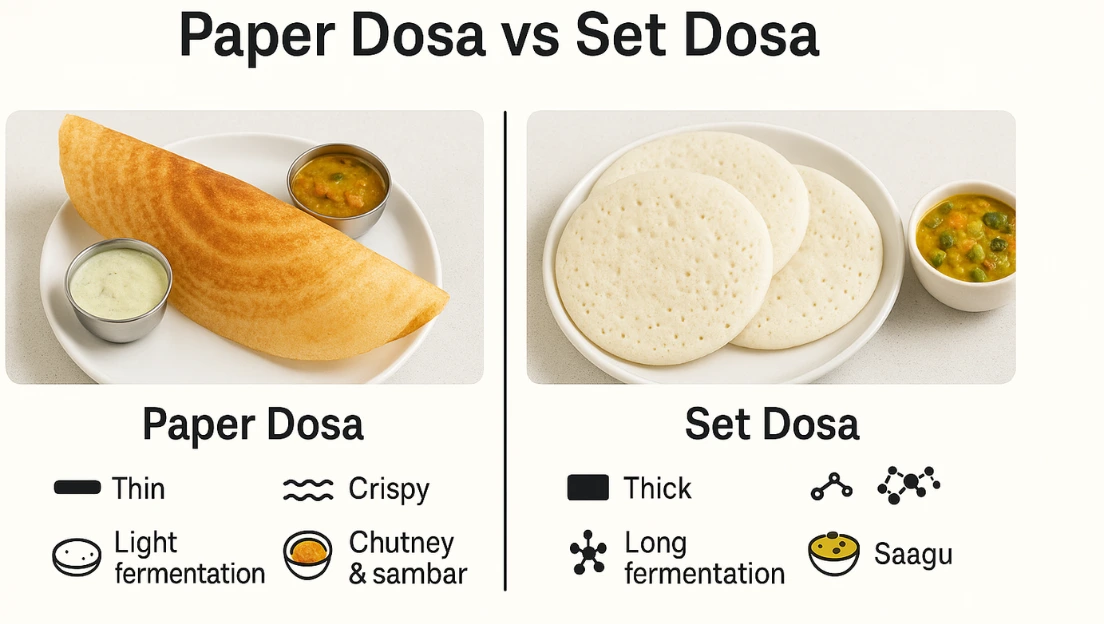Introduction
The dosa—a golden, crispy, paper-thin pancake—is a cherished staple of South Indian cuisine. Whether enjoyed as breakfast or a light dinner, this fermented rice-lentil crepe combines simplicity with depth of flavor. In this guide, we’ll explore how to make dosa recipe at home, break down each step clearly, and provide insights into regional dosa variations from Tamil Nadu and Karnataka. Whether you’re a culinary student or a home cook, this guide will help you perfect the art of dosa-making.
What is a Dosa?
Dosa is a traditional South Indian dish made from a fermented batter of rice and urad dal (split black gram). Rich in protein and easy to digest, dosa is commonly served with coconut chutney, tomato chutney, and sambar. It’s known for its crispy texture and mild tang from fermentation. So let’s know how to perfect Dosa Recipe at Home
Ingredients for Classic Dosa Recipe at Home Batter
- 3 cups parboiled rice (idli rice or dosa rice)
- 1 cup whole urad dal (split black gram)
- 1/2 tsp fenugreek seeds
- Salt to taste
- Water (for soaking and grinding)
- Oil or ghee (for cooking)
Step-by-Step Guide to Making Dosa Recipe at Home

1. Soaking the Ingredients
Time required: 4–6 hours
- Rinse the rice and urad dal separately under cold water until the water runs clear.
- Soak rice and fenugreek seeds in one bowl and urad dal in another with enough water.
2. Grinding the Batter
Tools required: Wet grinder or high-powered blender
- Grind urad dal with water until fluffy and smooth.
- Grind the rice to a slightly coarse texture.
- Combine both batters in a large bowl and mix well with your hands (this aids fermentation).
3. Fermenting the Batter
Time required: 8–12 hours (overnight)
- Cover the bowl and place it in a warm, draft-free place.
- In colder climates, use the oven light or an instant pot (yogurt mode).
- Once fermented, the batter should double in volume and develop a mild tangy aroma.
4. Preparing the Tawa (Griddle)
- Use a cast-iron or non-stick flat pan.
- Heat on medium flame and drizzle a few drops of oil.
- Wipe with a cut onion or cloth for even heat distribution.
5. Making the Dosa Recipe at Home
- Stir the fermented batter gently. Add salt to taste.
- Pour a ladle of batter onto the center of the tawa.
- Spread in a circular motion to form a thin circle.
- Drizzle a few drops of oil or ghee around the edges.
- Cook until the edges start lifting and the surface turns golden.
- Fold and serve hot.
Regional Comparison: Tamil Nadu vs Karnataka

| Feature | Tamil Nadu (Paper Dosa) | Karnataka (Set Dosa) |
|---|---|---|
| Thickness | Very thin, almost translucent | Thick and fluffy |
| Texture | Crispy | Soft and spongy |
| Fermentation Time | 10–12 hours | Slightly longer (12–14 hours) |
| Common Pairing | Coconut chutney, sambar | Chutney, saagu (vegetable curry) |
Tips for Crispy Dosa Recipe at Home
- Use aged rice or dosa rice for better fermentation.
- Add a spoonful of poha or cooked rice to enhance crispiness.
- Use minimal oil and a well-seasoned cast iron pan.
- Do not stir the batter vigorously after fermentation.
Serving Suggestions
- Coconut chutney: Freshly grated coconut, green chilies, ginger, and roasted chana dal.
- Tomato chutney: Tomatoes, onions, garlic, and dry red chilies sautéed and blended.
- Sambar: A spicy, tangy lentil soup with vegetables and tamarind.
Nutritional Benefits of Dosa at Home
- Naturally fermented—promotes gut health
- High in protein (from urad dal)
- Low fat when made with minimal oil
- Gluten-free and easily digestible
FAQs
Q1: How long dosa batter need to ferment?
A: Typically, dosa batter needs 8–12 hours to ferment, depending on ambient temperature. Warmer climates may take less time, while cooler regions require more.
Q2: What is the secret to crispy dosa?
A: The secret lies in using the right rice-dal ratio (3:1), proper fermentation, and a well-heated, seasoned pan. Adding a bit of poha or fenugreek seeds helps improve texture.
Q3: Can I make Dosa at Home without fermentation?
A: Yes, but it won’t taste the same. Instant dosa recipes use semolina or rice flour and curd but lack the depth and tang of fermented batter.
Q4: How is dosa different in Tamil Nadu and Karnataka?
A: Tamil Nadu favors thin, crispy paper dosas, while Karnataka’s set dosas are thick, soft, and spongy. Their chutneys and sides also differ.
Conclusion
Making dosa at home is both a skill and an art—rooted in tradition, science, and regional diversity. With a little practice and the right ingredients, anyone can master this classic South Indian breakfast.
Try making this authentic dosa recipe at home and bring the taste of South India to your kitchen—share your results or tips in the comments!
AI in 2025: How Artificial Intelligence Is Reshaping Everyday Life



